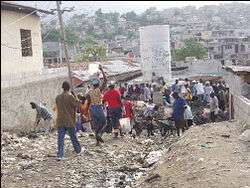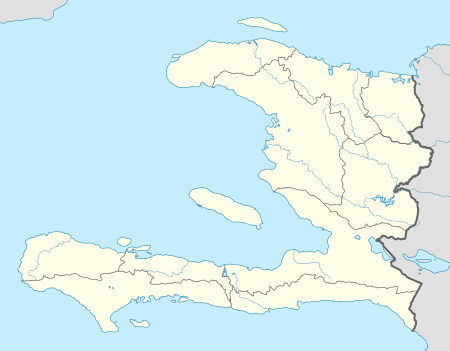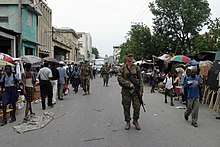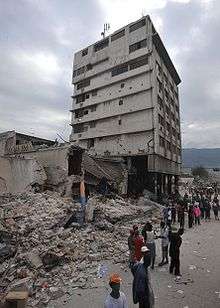Bel Air, Haiti
Bel Air (Haitian Creole: Bèlè, English: Good Air) is a neighborhood of Port-au-Prince, Haiti. It is a slum area of the city and suffers from poverty. Crime is widespread, and kidnappings and killings have created panic among the local population.[1] The neighborhood is also noted for housing a community of artists and craftsmen who produce inspired by Haitian Vodou, such as flags.[2][3]
Bel Air Bèlè | |
|---|---|
Neighborhood | |
 Ti Chery, Bel Air | |
 Bel Air Location in Haiti | |
| Coordinates: 18°33′N 72°20′W | |
| Country | |
| Department | Ouest |
| Arrondissement | Port-au-Prince |
History
Bel Air has served as a launching site for political demonstrations demanding the return of President Jean-Bertrand Aristide. In recent years it has been marred by political violence and massacres by police.[4]
In the late 19th century, Bel Air was the preferred place of settlement for British West Indian migrants to Haiti, the largest group of which were Jamaicans.[5]

On January 5, 2005 an uprising broke out and was suppressed by hundreds of Brazilian soldiers and special units of the Haitian National Police.[4] Five persons were reported to have been killed.[4] The trouble in the Bel Air area of the city was seen by the authorities as a major threat to the safety of the 2005 elections in Haiti.

The neighborhood was the most devastated area of Port-au-Prince after the 2010 Haiti earthquake.[6]
Crime
At the end of 2011, the murder rate in Bel Air reached 50 murders per 100,000 residents, up from 19 murders per 100,000 residents in 2010.[7]
References
- UNICEF
- Miller, Debra; Gorry, Conner (2005). Caribbean Islands. Lonely Planet. p. 252. ISBN 9781741040555.
- Nou La, We Here: Remembrance and Power in the Arts of Haitian Vodou. ProQuest. 2007. p. 125. ISBN 9780549453369.
- "UN occupies Bel Air in Haiti". Haitaction.net. Archived from the original on 22 January 2010. Retrieved January 16, 2010.
- Smith, Matthew J. (2014-10-20). Liberty, Fraternity, Exile: Haiti and Jamaica after Emancipation. UNC Press Books. pp. 216–217. ISBN 9781469617985.
- Fome e sede fazem violência aumentar em Porto Príncipe no Haiti Archived 2011-07-11 at the Wayback Machine (in Portuguese), Correio da Bahia. Retrieved on January 20, 2010.
- "Haiti’s Urban Crime Wave? Results from Monthly Household Surveys August 2011 - February 2012", Rio de Janeiro: Instituto Igarape. Kolbe, Athena R & Muggah, Robert (2012), p.4.